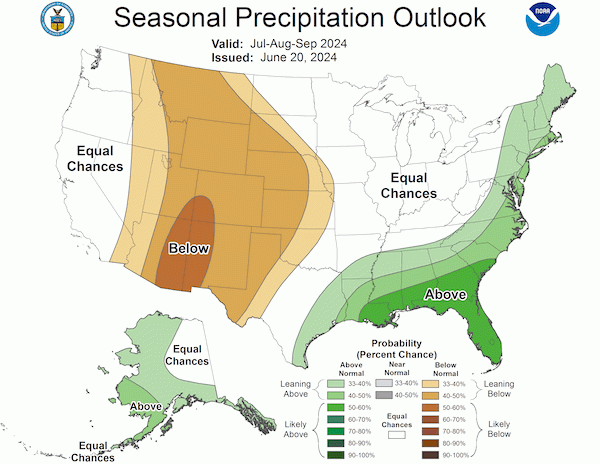Farmers in the US struggled through an overly wet planting season and are now facing unseasonably warm temperatures across a wide swath of corn and soybean regions. Heat is typically something that becomes a worry further along in the growing season but temps have already busted through the 100-degree mark in parts of the Midwest and are looking to maintain daytime highs of +90°F through most of this week, if not longer. Considering that the hottest months of summer are yet to come, it could mean that crops will be under stress throughout a good portion of the growing season.
Agronomists consider 86°F the optimum temperature for corn and soybean growth. Temperatures above 86°F slow important reactions, including those involved in photosynthesis, reducing yield potential.
In general, air temperatures don’t matter as much to plants as leaf temperature. According to University of Missouri Extension agronomist Bill Wiebold, leaves absorb light to build sugars and other things needed for life and yield. Plants use little of the available light energy. Extra energy causes leaf temperature to rise, he says.
Changing water from liquid to vapor (evaporation) uses a sizable amount of energy and causes a cooling effect. Conduction occurs when the warm leaf surface returns energy to the air that touches it if the air temperature is lower than the leaf temperature. In convection, cooler air moves closer to the surface of the leaf and displaces warmer air.
During the day, leaf temperatures are often higher than air temperatures, especially on bright, sunny days with little wind, says Wiebold. With good moisture supplies, evaporation happens quickly enough to keep leaf temperatures near air temperature. However, with limited moisture, water may not evaporate fast enough to cool the leaf. This causes leaf temperature to rise. Conduction and convection are not effective at driving heat away from the leaf when air temperatures are high.
The direct effect of high temperature on crop yields is small in most years, Wiebold says. But when temperatures top 95°F, corn and soybean yields may drop even in areas where there is adequate precipitation.
One less obvious effect of high temperatures occurs in photosynthesis and respiration, he says. In the plant world, photosynthesis is “income” and respiration an “expense.” The difference, net photosynthesis, is “net income.” Within reason, high net photosynthesis high yield. High temperatures fuel respiration more than photosynthesis and reduce the plant’s “net income.” This is especially true at night, when no photosynthesis occurs. Warm nights can lower yield without any visible effects on the plants.
High daytime humidity can benefit plants because lower evaporation reduces water stress. High nighttime humidity slows the rate at which air temperatures fall. It is not uncommon for temperatures to remain above 80°F on summer nights if humidity is high (dew point above 70°F). So, although plants do not “feel” a high heat index, the slow rate of temperature decline during high-humidity nights shows through increased respiration.
Corn and Extreme Heat: For corn, the number one concern with high heat is pollination. Heat stress alone will not usually negatively impact corn pollination if soil moisture levels are adequate, although prolonged temperatures over 100°F can kill pollen. According to Iowa State University, pollen shed occurs over a two-week period. For kernels to develop, silks must emerge and be fertilized by viable pollen. Temperatures greater than 95°F with low relative humidity will desiccate exposed silks, but not impact silk elongation rates greatly. Pollen is no longer viable once temperatures reach the mid 90’s or greater, especially with low relative humidity. Fortunately, pollen shed usually occurs from early to mid-morning when temperatures are lower.
Kernel abortion can occur when successful pollination is followed by drought or heat stress and is usually more frequent at the ear tip. Drought or heat stress during the first 2 weeks after pollination is the most critical in determining if abortion will occur. The ideal temperature range for corn is between 86°F for daytime and 50°F for nighttime temperatures. When daytime temperatures are high, photosynthetic capacity is reduced, so less sugars are produced. Coupled with high nighttime temperatures the respiration rate is increased using the reduced amount of sugars produced impacting the number of kernels set and filled.
Soybeans and Extreme Heat: The ideal daytime temperature for soybean growth is 85℉. When temperatures exceed this threshold, especially for several subsequent days, heat stress can occur regardless of growth stage. Soybeans will be particularly stressed when excessive heat and drought conditions occur simultaneously and drive up soil temperatures leading to reduced moisture and nutrient uptake. High temperatures are somewhat less problematic during wet conditions. Soybeans are less sensitive to high nighttime temperatures than corn, however yield impact can still be seen if nighttime temperatures exceed 85℉. Heat can also accelerate soybean maturity, as photoperiod and temperature interact to control flowering in soybeans.
Temperatures above 86℉ can also reduce nodulation, and ultimately N-fixation in soybeans, and the effects could extend into the reproductive growth stages.
High temperatures in reproductive stage soybeans can result in aborted flowers, aborted small pods, aborted seeds in larger pods, and production of smaller seeds. Leaf loss can even occur under severe stress. Soybeans flower for several weeks so they have the opportunity to withstand short-term periods of stress. At the R3 stage – marked when the plant has a pod on at least one of the upper four nodes of 3/16-inch long or longer – heat or moisture stress can reduce pod numbers, seed number per pod, or seed size, which may reduce yield potential. The ability for soybean plants to recover from temporary stress decreases from R1 to R5. (Sources: University of Missouri Extension, Iowa State University Extension, NOAA, USDA)












